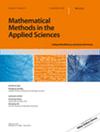Qualitative Stochastic Homogenization of Elliptic Equations With Random Coefficients and Convolutional Potentials
IF 1.8
3区 数学
Q1 MATHEMATICS, APPLIED
引用次数: 0
Abstract
This paper deals with the homogenization problem for elliptic equations with random statistically homogeneous ergodic coefficients and convolutional potentials in bounded domains. Assuming that the potential has a small absolute expectation, we prove the almost sure qualitative homogenization results in the weak topology in by Tartar's perturbed test function method. Moreover, for bounded -domains, with the aid of the sublinear growth properties of correctors, we also prove the qualitative stochastic homogenization results in the strong -topology via two-scale expansion method.
具有随机系数和卷积势的椭圆方程的定性随机均匀化
研究了有界域中具有统计上随机齐次遍历系数和卷积势的椭圆方程的均匀化问题。假设势的绝对期望很小,用Tartar摄动测试函数法证明了h0 1 $$ {H}_0^1 $$弱拓扑中几乎肯定的定性均质化结果。此外,对于有界的c2, α $$ {C}^{2,\alpha } $$ -结构域,借助于校正器的次线性增长性质,并利用双尺度展开方法证明了强h1 $$ {H}^1 $$ -拓扑下的定性随机均匀化结果。
本文章由计算机程序翻译,如有差异,请以英文原文为准。
求助全文
约1分钟内获得全文
求助全文
来源期刊
CiteScore
4.90
自引率
6.90%
发文量
798
审稿时长
6 months
期刊介绍:
Mathematical Methods in the Applied Sciences publishes papers dealing with new mathematical methods for the consideration of linear and non-linear, direct and inverse problems for physical relevant processes over time- and space- varying media under certain initial, boundary, transition conditions etc. Papers dealing with biomathematical content, population dynamics and network problems are most welcome.
Mathematical Methods in the Applied Sciences is an interdisciplinary journal: therefore, all manuscripts must be written to be accessible to a broad scientific but mathematically advanced audience. All papers must contain carefully written introduction and conclusion sections, which should include a clear exposition of the underlying scientific problem, a summary of the mathematical results and the tools used in deriving the results. Furthermore, the scientific importance of the manuscript and its conclusions should be made clear. Papers dealing with numerical processes or which contain only the application of well established methods will not be accepted.
Because of the broad scope of the journal, authors should minimize the use of technical jargon from their subfield in order to increase the accessibility of their paper and appeal to a wider readership. If technical terms are necessary, authors should define them clearly so that the main ideas are understandable also to readers not working in the same subfield.

 求助内容:
求助内容: 应助结果提醒方式:
应助结果提醒方式:


